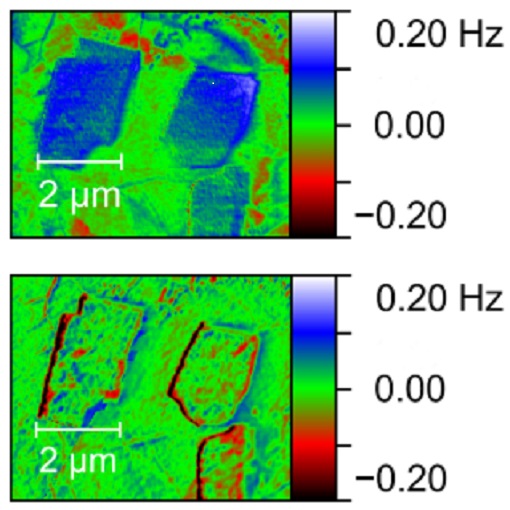
2D magnetic polymers
Exfoliation has become established method for fabrication of van der Waals (vdW) materials. Yet, it is less suitable in case of vdW magnets since many of them are instable at ambient conditions. The group of Eugenio Coronado (University of Valencia, Spain) prepared and studied 2D magnets utilizing pre-synthetic functionalization and subsequent exfoliation of layered magnetic coordination polymers featuring Fe(II) centers and different benzimidazole derivatives. They characterized mechanical and magnetic properties of 2D magnetic polymers. Utilizing an attoMFM microscope in an attoDRY1000 cryostat, they identified magnetic ordering in polymers, as well as the signature of the transition from a canted antiferromagnetic phase to a paramagnetic phase. Their study renders 2D magnetic polymers as promising playground for studying fundamental aspects of 2D magnetism.
This measurement was realized with the attoDRY1000, and the attoAFM I.
Further reading:
J. López-Cabrelles etJ. al., Nature Chemistry 10, 1001 (2018)
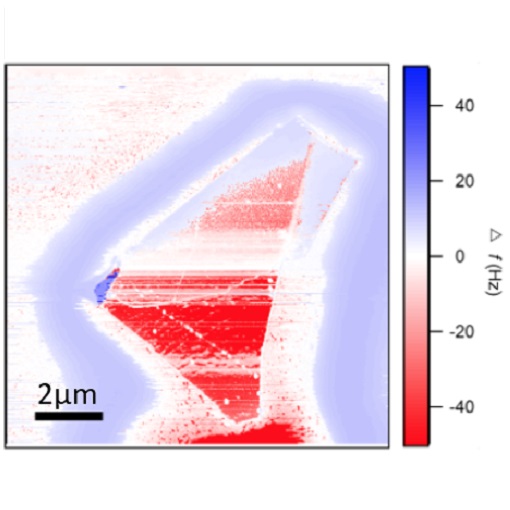
Beyond Ising and Heisenberg
Properties of low-dimensional magnets are strongly influenced by higher-order exchange interactions and quantum effects. The same holds for a van der Waals (vdW) magnet CrI3, which is a quantum material with magnetic properties that cannot be described by Ising or Heisenberg model alone, as demonstrated in a collaboration lead by Eugenio Coronado (University of Valencia, Spain), Kostya Novoselov (National University of Singapore, Singapore & University of Manchester, UK) and Elton Santos (University of Edinburgh, UK). Moreover, the metastability of magnetic domains in CrI3 induces a homogeneous magnetization or even a single domain over the entire surface, which has been imaged by an attoMFM in an attoDRY1000 cryostat. Such domains exhibit hybrid characteristics of both Neel and Bloch type. This study exemplifies how intricate magnetism of vdW magnets can be understood by combining experimental techniques with theoretical calculations, which is a prerequisite of applications of 2D magnets.
This measurement was realized with the attoDRY1000, and the attoAFM I.
Further reading:
D. Abdul Wahab et al., Advanced Materials 33, 2004138 (2021)
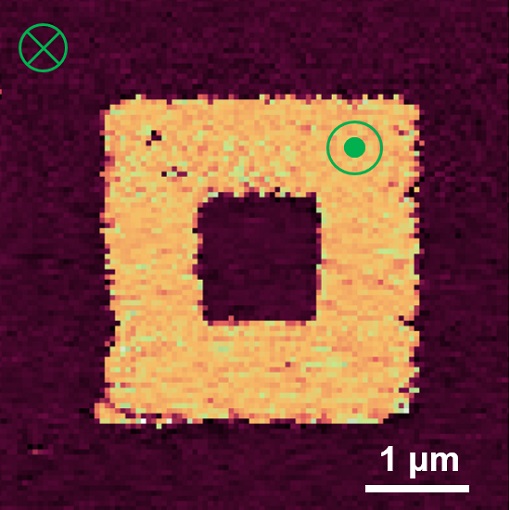
Emergent magnetoelectric phase transition
Complex oxides with a broken symmetry can exhibit various, often emergent, phases. This is in particular facilitated by designing superlattices of complex oxides. The group of Jinxing Zhang (Beijing Normal University, China) has constructed a superlattice by alternately stacking a Ruddlesden–Popper and a perovskite oxide, which resulted in artificially designed ferroelectricity and emergent magnetoelectric (ME) phase transition. The existence of ferroelectric domains below 90 K has been verified by PFM, by using an attoAFM I microscope with a PFM upgrade in an attoDRY1000 cryostat. The accompanying existence of Dzyaloshinskii–Moriya interaction (DMI) and net magnetization have been verified by Brillouin light scattering. Furthermore, external magnetic field suppresses electrical polarization, which confirms the existence of a direct ME effect. This study shows that engineering of interfacial DMI is a promising tool for generating exotic phases and orders in systems with correlated electrons.
This measurement was realized with the attoDRY1000, and the attoAFM I.
Further reading:
X. Liu et al., Nature Commun. 12, 5453 (2021)
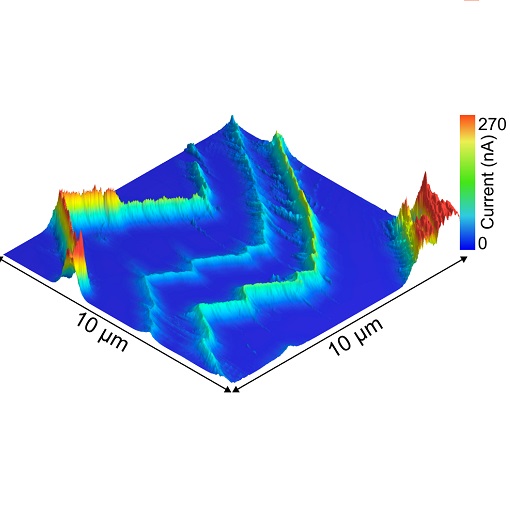
Conducting domain walls in quantum materials
Conducting domain walls (DWs) are quasi-2D conducting pathways that can be created, positioned, and removed in-situ, giving an opportunity for rewritable nanoelectronics. In this young field, conducting DWs typically arise in wide band-gap ferroelectrics where they can form in response to charge build up at polar discontinuities. The chair of István Kézsmárki (University of Augsburg, Germany) has shown that conducting DWs can also exist in narrow-gap Mott insulators. In this case, it was shown that the nanoscale conducting pathways form because of strain gradients around the DWs that change the band structure.
The team used an attoAFM I microscope with a ct-AFM upgrade and a PFM upgrade in an attoLIQUID2000 cryostat to cool their template material (GaV4S8) below its Jahn-Teller transition (~43 K) before directly imaging the conductivity, the topography, and the piezoresponse. From this they were able to rule out the polar discontinuity model as the origin, rather correlating the increase in conductivity around the DWs to the square of height of the surface reconstruction: a signature of the volume strain that arises across the Jahn-Teller transitions. Effectively, this shows a new mechanism for creating nanoscale conducting pathways using strain-gradient-induced changes in band structure. This opens the exciting door for many new materials to be considered for domain wall nanoelectronics.
This measurement was realized with the attoAFM I.
Further reading:
L. Puntigam et al., Adv. Electron. Mater. 2022, 2200366 (2022)
Elucidated behavior of a ferroelectric-semiconductor phototransistor
Low-light-level photodetectors (3LPDs) are key ingredients for quantum photonics devices, as well as in astronomy. To be compatible with complementary metal oxide semiconductors (CMOS) technology, they need to operate at low voltages, which is not the case as of now. The team lead by Zhihai Cheng (Renmin University of China, China) and Zhenxing Wang (National Center for Nanoscience and Technology, China) has fabricated and characterized low-light-level ferroelectric-semiconductor phototransistor (FSP) with an intrinsically high gain, featuring photo-induced ferroelectric switching. To unravel the photoresponse mechanism, they carried out in-situ EFM and KPFM on the FSP devices, in which the ferroelectric-semiconductor channels were identified by PFM. These correlative measurements have been realized by an attoAFM I microscope in an attoDRY2100 cryostat, with a KPFM upgrade and a PFM upgrade. This FSP demonstrates potential for novel generation of 3LPDs, due to its low operating voltage, high performance and simple architecture.
This measurement was realized with the attoDRY2100, and the attoAFM I.
Further reading:
J. Yang et al., Adv. Funct. Mater. 2022, 2205468 (2022)
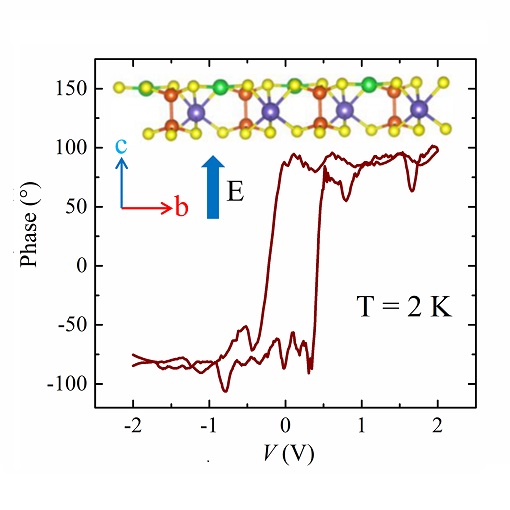
A van der Waals multiferroic
Coexistence of ferromagnetic and ferroelectric ordering in multiferroics makes these materials promising candidates for a next generation of storage devices. Collaboration of several Chinese universities studied a van der Waals (vdW) multiferroic CuCrP2S6 and found therein in-plane electrical and magnetic anisotropies with the same easy axis. Utilizing an attoAFM I microscope with PFM upgrade in an attoDRY2100 cryostat, Zhihai Cheng (Renmin University of China, China) performed piezoresponse force microscopy (PFM) measurements which indicate that the out-of-plane electric dipole originates from the antiferroelectric domain walls. Their findings - which include also the abilty to manipulate the magnons in CuCrP2S6 by electric field, magnetic field and temperature - demonstrate the potential of vdW multiferroics for applications in low-power and high-density non-volatile memories.
This measurement was realized with the attoDRY2100, and the attoAFM I.
Further reading:
X. Wang et al., Nature Commun. 14, 840 (2023)
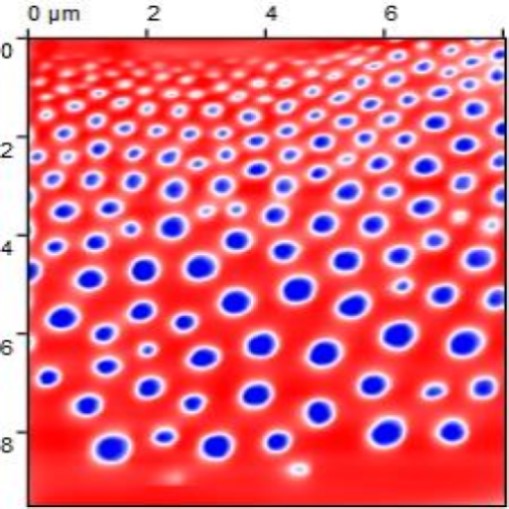
Constituents of racetrack memory devices
The quest for next-generation energy-efficient and ultra-high-density spintronic devices has been driving extensive research of magnetic skyrmions and antiskyrmions. These topologically protected non-collinear magnetic domain walls are promising candidates for carrying information in racetrack memory devices. The group of Stuart Parkin (Max Planck Institute for Microstructure Physics, Germany) has been leading the research in that direction, utilizing an attoAFM I microscope with an attoMFM upgrade in an attoLIQUID2000 cryostat. Below we summarize some of their recent results.
In a Heusler compound Mn1.4PtSn they found the size of antiskyrmions to be tunable by means of varying the thickness of the hosting single-crystal lamella, which was ascribed to the influence of magnetic dipolar interactions. Study of another Heusler compound, Mn2RhSn, reveals spin textures stabile over a wide range of temperature and magnetic field, similarly to the aforementioned single-crystalline case. Interestingly, creation and annihilation of these spin textures can be achieved with local magnetic field emanating from the magnetic tip of the cantilever, which opens the way towards skyrmionic devices base on Heusler thin films. Furthermore, they discovered that the size of Néel skyrmions in 2D layered ferromagnet Fe3GeTe2 is also proportional to the lamella thickness, and that the Dzyaloshinskii–Moriya Interaction therein is driven by the asymmetric distribution of Fe vacancies.
This measurement was realized with the attoAFM I.
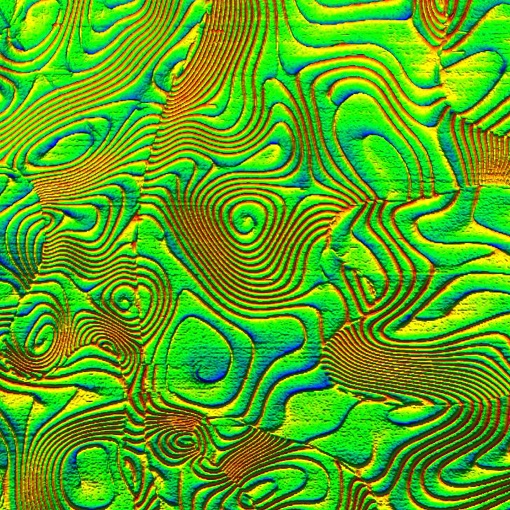
Zooming into heterochiral magnets
Topological spin textures have been in focus of nanoscience for years due to their applications potential in novel generation of spintronic devices. Yet, almost all effort has been dedicated to the study of homochiral states. Hence, little is known about long-range interactions between domains of opposite handedness, as well as how magnetic states are affected by high density of chiral domains and domain walls. The group of Sang-Wook Cheong (Rutgers University, USA) explored a layered chiral helimagnet Cr1/3TaS2 with tunable topological heterochiral states. By tuning the density of chiral domains, which can be achieved by varying the cooling rate at the phase transition, they observe inside each domain a topological magnetic texture in the form of a spiral composed of quasiperiodic Néel walls. Weak in-plane magnetic fields turn this spiral superstructure into a non-spiral array of concentric ring domains. These results have been achieved by utilizing an attoAFM I with attoMFM upgrade in an attoLIQUID2000 cryostat. The authors assign the existence of magnetic spirals to intrinsic strain present in the heterochiral state, which renders layered heterochiral materials interesting for applications in strain-tunable magnetic devices.
This measurement was realized with the attoAFM I.
Further reading:
K. Du et al., PNAS 118, e2023337118 (2021)
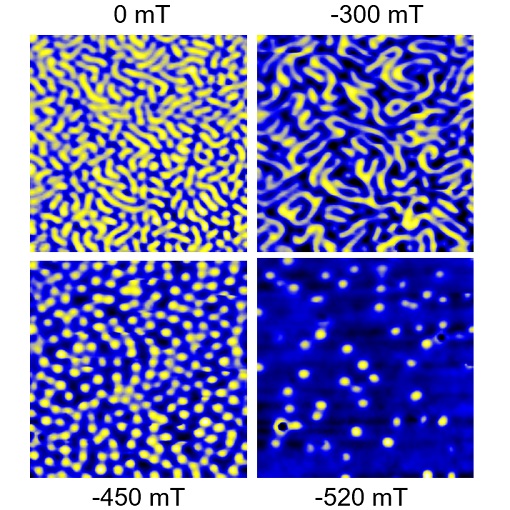
Skyrmions induced by strain gradient
Dzyaloshinskii-Moriya interaction (DMI) arises from breaking the inversion symmetry in noncentrosymmetric crystals, or emerges at thin-film interfaces. DMI and its relation to magnetic anisotropy are decisive in creating conditions for creation of chiral spin structures. The group of Prof. Jinxing Zhang (Beijing Normal University, China) has shown how DMI can be generated in a centrosymmetric material La0.67Sr0.33MnO3 by a strain gradient. Such DMI induces topological spin textures (skyrmions and spin spirals) accompanied by topological Hall effect in the range from 20 - 300 K. They imaged skyrmions and spin spirals by magnetic force microscopy (MFM) utilizing an attoAFM I microscope with attoMFM upgrade in an attoDRY1000 cryostat. Their findings open the path to exploring the potential for centrosymmetric magnetic materials in spintronics applications.
This measurement was realized with the attoDRY1000, and the attoAFM I.
Further reading:
Y. Zhang et al., PRL 127, 117204 (2021)
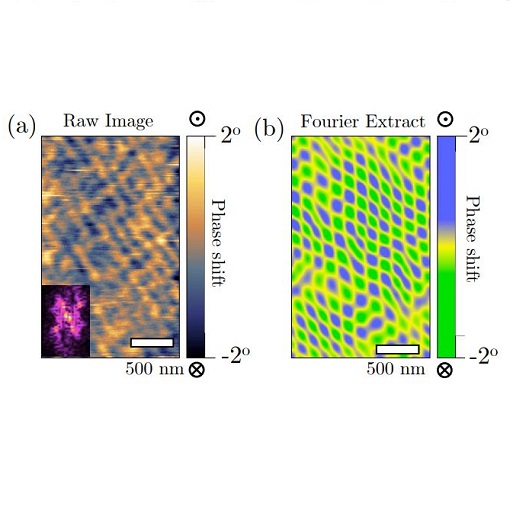
Ferroelectrically induced magnetic spin crystal
Whether the presence of skyrmions is the underlying cause for the topological Hall effect (THE) observed in SrRuO3 (SRO) heterostructures, is a matter of dispute, as conflicting experimental evidences exist. Samuel Seddon (Group of Marin Alexe, University of Warwick, UK) has conducted a series of magnetic force microscopy (MFM) measurements on a ferroelectric-SRO bilayer. These show that the breaking of inversion symmetry at the interface, induced by the strong polarization in the ferroelectric layer, does not induce skyrmions but rather an incommensurate spin crystal, that exists over the field range of THE. For the magnetic force microscopy (MFM) measurements they have been utilizing an attoAFM I microscope with attoMFM upgrade in an attoLIQUID2000 cryostat. Their findings exemplify that complex oxides host extremely reach physics, many aspects of which are yet to be unraveled.
This measurement was realized with the attoAFM I.
Further reading:
S.D. Seddon et al., Nature Commun. 12, 2007 (2021)
Revealing physical origin of electronic phase separation in complex oxides
Manganites exhibit various nonlinear responses to external stimuli, which makes them potentially useful materials for electronic devices. While nonlinear responses in complex oxides have been correlated to large-scale electronic phase separation (EPS), the physical origin of EPS has for a long time remained puzzling. The group of Jian Shen (Fudan University, China) has provided the first experimental evidence that the disorder induced by chemical doping is a prerequisite for EPS, thus verifying the theoretical predicition.
This result has been directly obtained by comparative MFM measuerments on chemically ordered manganite film vs. the chemically disordered one, utilizing an attoAFM I with attoMFM upgrade in an attoDRY1000 cryostat. Their finding opens the path to focused design of complex oxides with desired properties for applications, especially those exhibiting colossal magnetoresistance.
This measurement was realized with the attoDRY1000, and the attoAFM I.
Further reading:
T. Miao et al., PNAS 117, 7090 (2020)
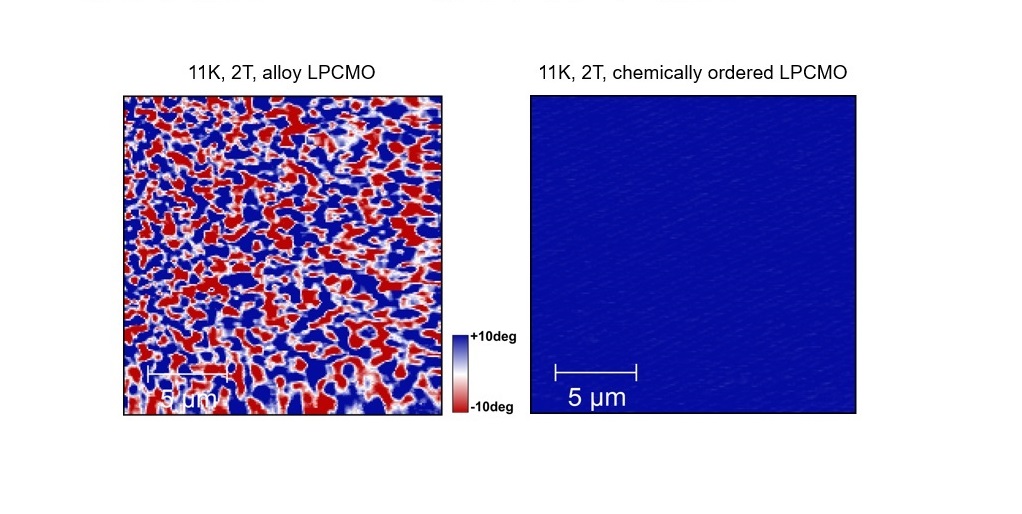
Extremely narrow magnetic domain walls in U ferromagnets
The ferromagnetic UCoGa - from the family of UTX compounds - features a strongly anisotropic uniaxial magnetization with the magnetic domains being pinned to the lattice defects during the transition phase. Using attoAFM, the group of Jan Prokleska at the Charles University (Prague, CZ) showed in direct low-temperature investigations the magnetization and demagnetization procedure of UCoGa with increasing/decreasing applied magnetic field. Further analysis of the measurements supports the idea that the very narrow domain walls are formed by the pairs of the nearest U neighbor ions with antiparallel magnetic moments within the basal plane.
This measurement was realized with the attoAFM I.
Further reading:
P. Opletal et al.,Materialstoday 24, 101017 (2020)
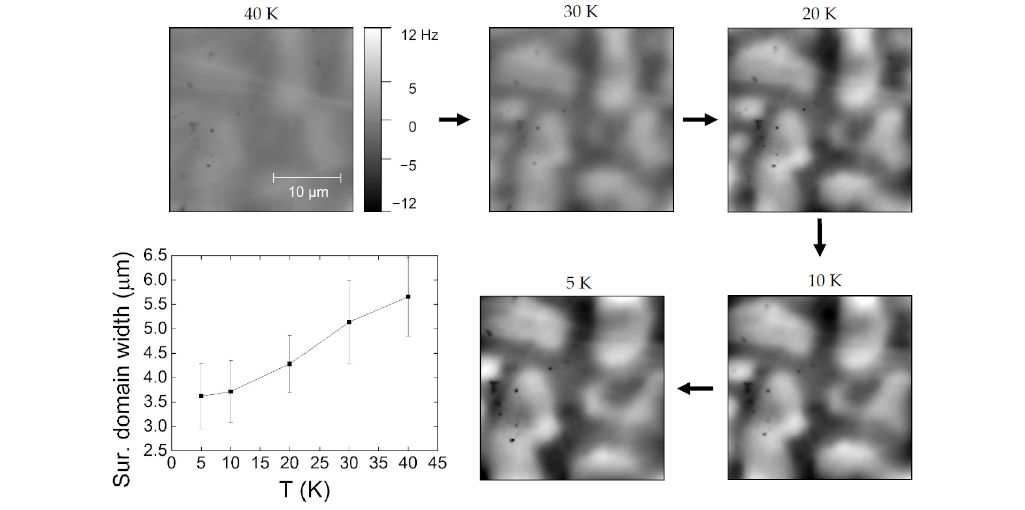
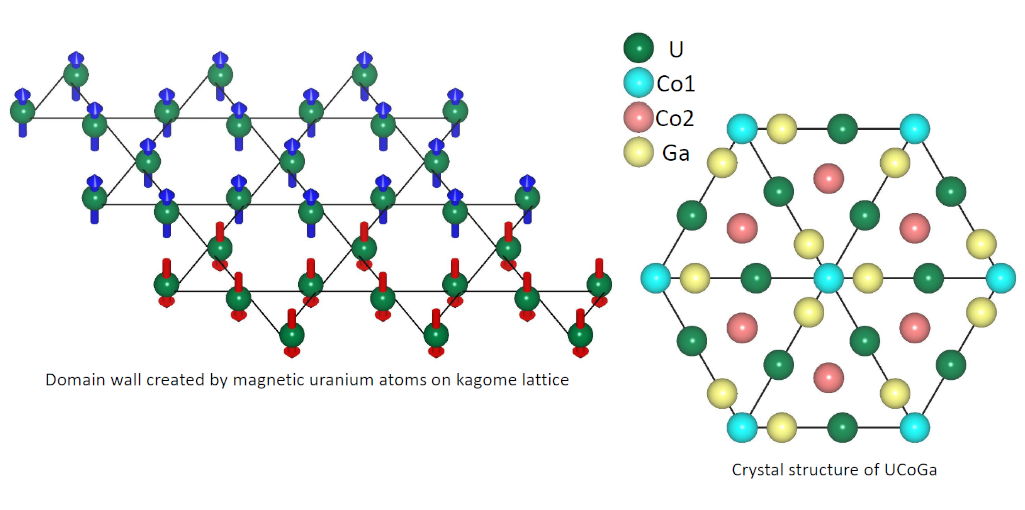
Discovery of Intermediate State in the Metal-Insulator Transition
A closer look at the state configuration of a first-order metal-insulator transition illuminates the coexistence of the metallic and insulating phases at ultra fast timescales. Based on their former work [1] the group of Jian Shen at the Fudan University (Shanghai, CN) witnessed a third long-living intermediate state emerging at the photoinduced first-order metal-insulator transition of La0.325Pr0.3Ca0.375MnO3, building a bridge between the other two states [2].
The attoAFM used in dual pass mode delivered not only the topography of the sample but also the magnetic distribution on the nm scale. Combined with Magneto Optical Kerr Effect (MOKE) measurements the authors identified the third state as a mixture of the ferromagnetic metallic and the charged-ordered insulating states. These findings open the door to create two completely different characteristic length of phase separation in first order metal-insulator transitions. In a next step it will be interesting to see if the results can be adapted to other first-order metal-insulator transitions in different condensed matter systems.
This measurement was realized with the attoAFM I.
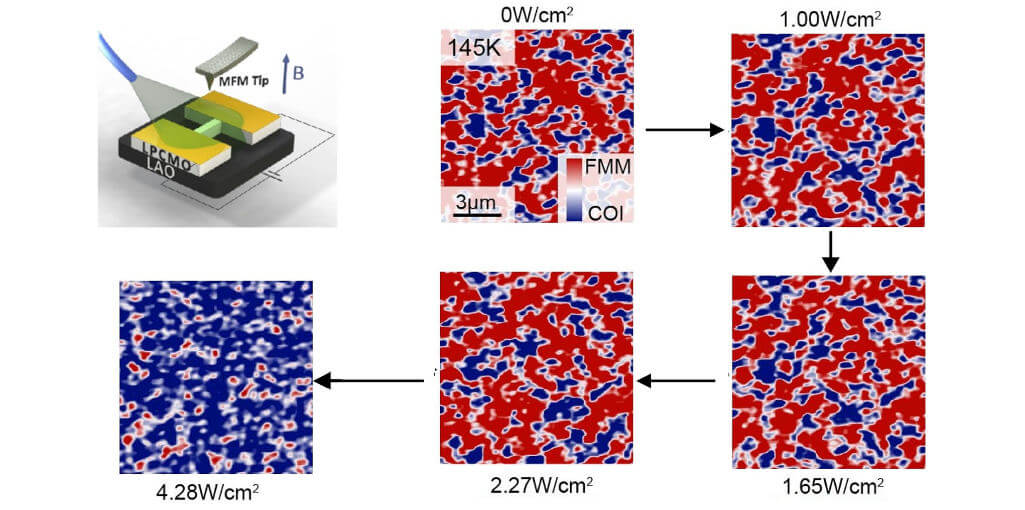
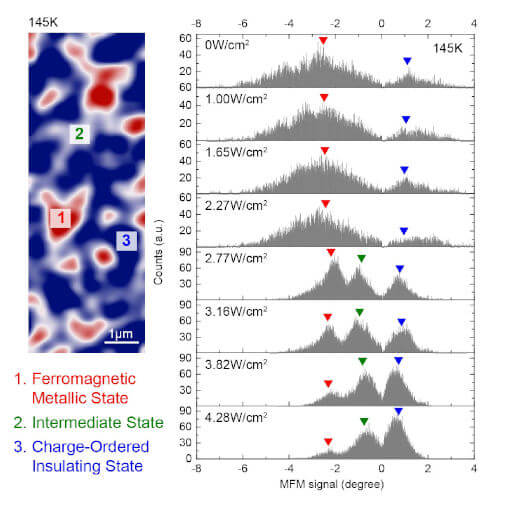
Isolating Hydrogen Gas inside H-BN Bubbles
Storing small amounts of gas even on the atomic scale is extremely interesting for a lot of research fields. The choice of the barrier material plays an important role: It has to form bubbles to surround the stored gas, it has to be stable under extreme conditions, and it shall not interfere with the enclosed gas on chemical or physical terms. The group of Haomin Wang at the Chinese Academy of Sciences (Shanghai, CN) now presents new results on the production of isolated hydrogen inside hexagonal boron nitride (h-BN) bubbles via plasma treatment.
Low temperature atomic force measurements were carried out to prove that the surrounded gas is indeed hydrogen. Therefore, the authors used a cryogenic atomic force microscope, the attoAFM I, cooled by the closed cycle cryostat attoDRY1100, the 4 K version of the attoDRY2100. Setting exactly the measurement temperature and performing temperature sweeps gave the researches the possibility to show the bubble’s disappearance at a temperature of 33.2 K ± 3.9 K indicating a transition or disappearing of the enclosed gas. As this temperature is close to condensing temperature of H2 (33.18 K), the results point to the presence of atomic hydrogen inside the h-BN bubbles. The successful production of hydrogen inside the bubbles and presented results are a next step for hydrogen storage.
This measurement was realized with the attoDRY2100, and the attoAFM I.
Further reading:
Li He, et al; Nature Communications 10, 2815 (2019)
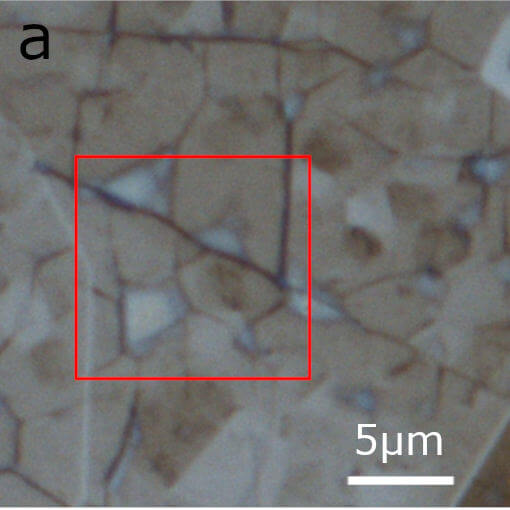
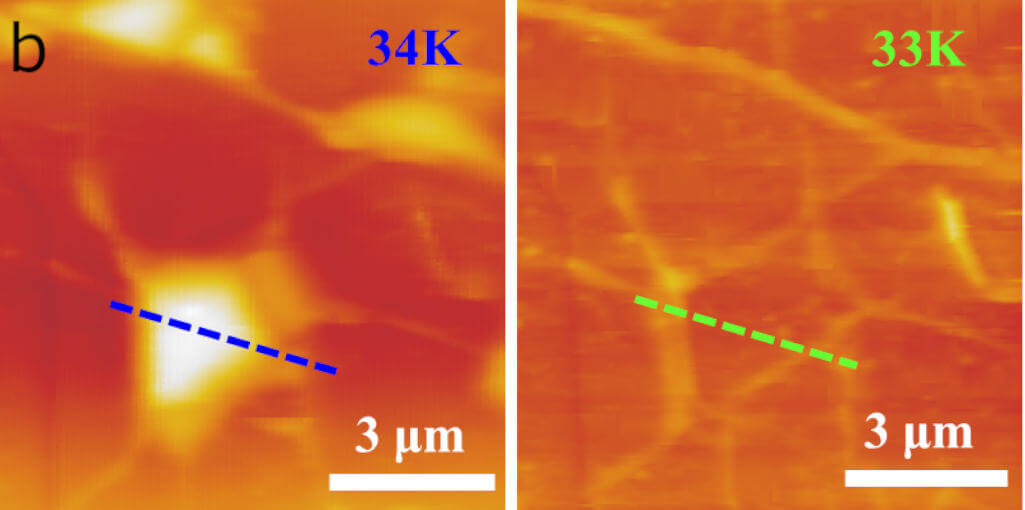
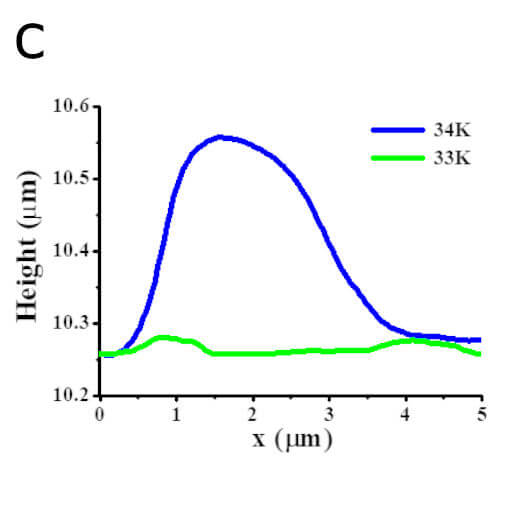
Uncompensated Bound Charges at Improper Ferroelectric Domain Walls
The research focus of an international team led by researchers from NTNU Trondheim, ETH Zurich, and Institut Néel, CNRS, lies on domain walls in improper ferroelectrics, a promising type of functional interface for nanoscale electronics. The team demonstrated the stability of improper ferroelectric domain walls in hexagonal manganites against electrically uncompensated bound charges.
Using the attoAFM I, the authors investigated the electronic domain-wall transport, carrier distribution, and electrostatics at temperatures down to 4.2 K. attocube's atomic force microscope, the attoAFM I, enables atomic force microscopy at cryogenic temperatures, down to mK. The findings provide new insight into the fundamental domain-wall properties, bringing us yet another step closer towards next-generation's durable and ultra-small electronic components.
This measurement was realized with the attoAFM I.
Further reading:
Peggy Schoenherr, et al.; Nano Lett.19, 3, 1659-1664 (2019)
Fine-scale Stripey Morphology of an Iron Pnictide - New Findings in Material Science
Iron-based superconducting pnictides feature relatively high transition temperature and a co-existence of the superconducting state with antiferromagnetic ordering. This remarkable combination brings these materials into the focus of research. The group of Prof. Susannah Speller at the Materials Department of the University of Oxford (Oxford, UK) used an attoAFM I cooled by a closed cycle attoDRY1000 for magnetic force measurements at about 4.6 K to investigate the local electronic structure and chemistry of RbxFe2-ySe2 crystals.
The group showed a fine-scale stripey morphology of the superconducting phase which - combined with previous findings - paves the way to understand the intriguing electronic and magnetic properties of these compounds.
This measurement was realized with the attoDRY1000, and the attoAFM I.
Further reading:
P Dudin et al.; Supercond. Sci. Technol. 32, 044005 (2019)
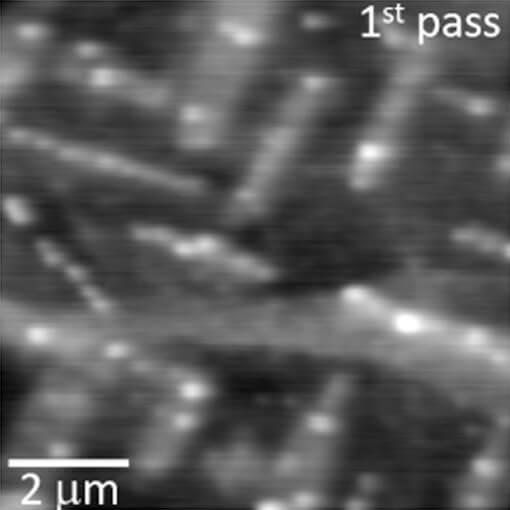
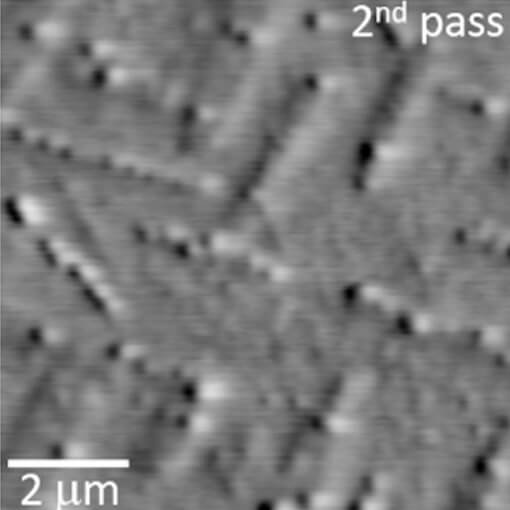
Measurements of field-driven transformation of a domain pattern
The group of Erik Folven at the Norwegian University of Science and Technology (Trondheim, Norway) used an attoAFM I for MFM measurements with a closed cycle attoDRY1000 to demonstrate how topological defects may be invoked to understand magnetic domain state transitions. The atomically sharp and magnetized tip of the microscope is scanned across the thin film surface to pick up the out-of plane stray fields from the sample and thus is sensitive primarily to spin textures such as domain walls and defects. The MFM measurements taken at 5K help to understand and describe micromagnetic domain state transitions and to assess their stability in remanence. This insight may open for new approaches to control the switching properties of micro- and nanomagnets.
This measurement was realized with the attoDRY1000, and the attoAFM I.
Further reading:
S. D. Sloetjes, et al., Appl. Phys. Lett. 112, 042401 (2018)

Robust skyrmions in conducting crystal
Racetrack memory with skyrmions has been envisaged as a novel spintronic device. Main challenge for its implementation are defects in suitable conducting ferromagnets. Moreover, Racetrack memory with Néel skyrmions would be more energy-efficient than Racetrack memory with Bloch skyrmions. Therefore, researchers have been focusing on Néel skyrmions, which predominantly appear on interfaces in thin films, usually accompanied by defects. Now, the group of Stuart Parkin at Max Planck Institute for Microstructure Physics (Germany) reported the first observation of Néel skyrmions in a bulk conducting crystal. They exhibit stability over a wide range of temperature and magnetic field, as well as tunability of their size with the thickness of the crystal. Such robustness of skyrmions, that were imaged by an attoAFM I cooled down by an attoLIQUID2000 cryostat, makes their host material (PtMnGa) promising for RM devices. As PtMnGa is of a class of highly tunable compounds their findings mark a first step towards tailored skyrmion properties for future spintronic applications.
This measurement was realized with the attoAFM I.
Further reading:
A.K. Srivastava et al., Advanced Materials 32, 1904327 (2020)
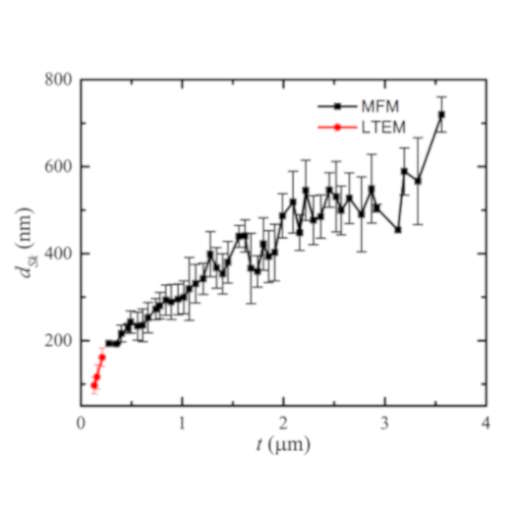
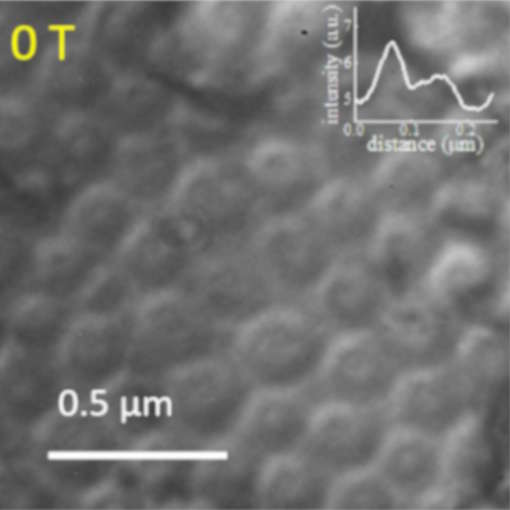
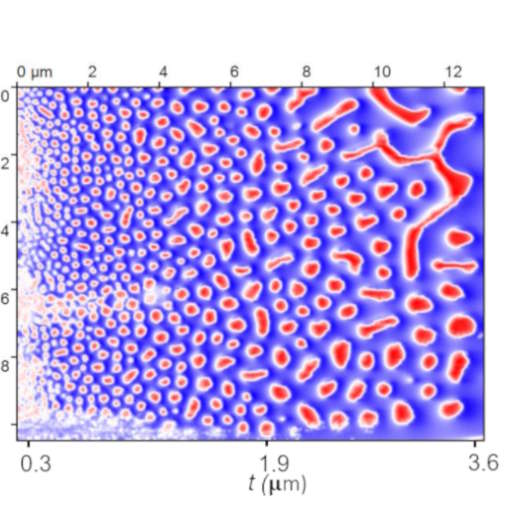
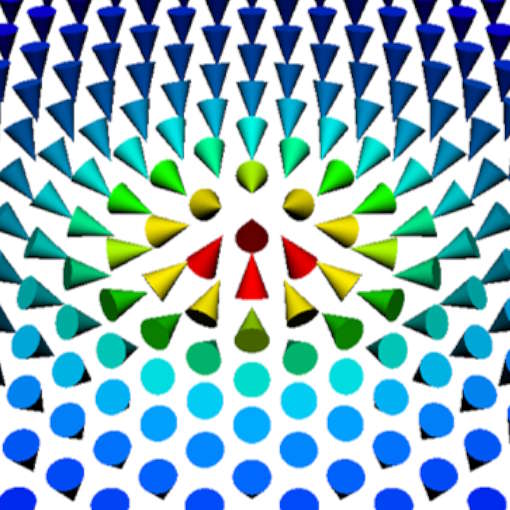
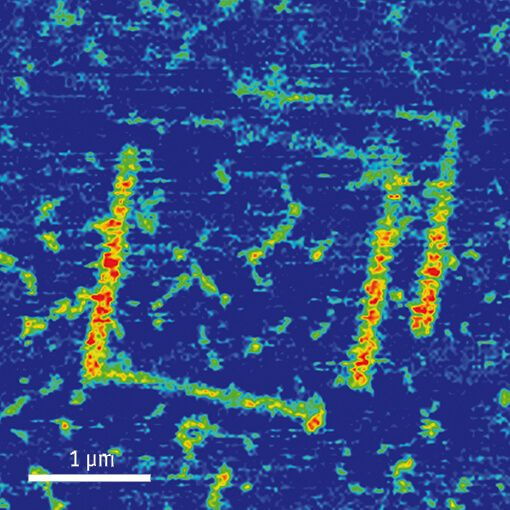
Piezoresponse Force Image on BFO
This image shows the attocube logo electrically written into a BaFeO3 substrate next to natural domains of the sample. The data were taken at cryogenic temperature of 4 K in piezoresponse force mode using an attoAFM I inside a liquid helium cryostat. Image size is 5 x 5 µm2.
This measurement was realized with the attoAFM I.
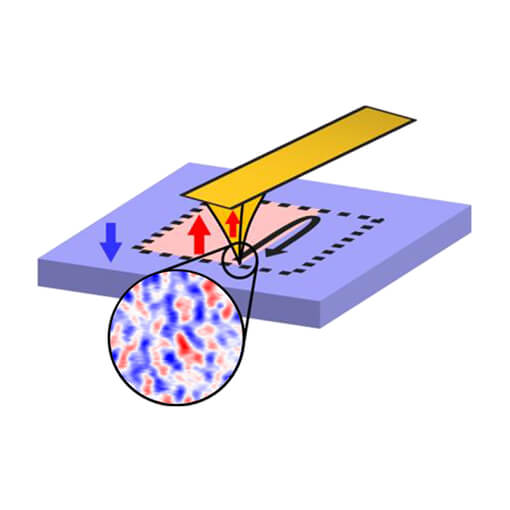
Quantized Conduction on Domain Walls of a Magnetic Topological Insulator
In a paper published in Science, researchers from the University of Tokyo and RIKEN (Japan) have studied “Quantized conduction on domain walls of a magnetic topological insulator” using an attoAFM/MFM in a 3He-cryostat down to 500 mK. In their paper, Yasuda et al. designed and fabricated magnetic domains in the quantum anomalous Hall state, and proved the existence of the chiral one-dimensional edge conduction along the domain walls through transport measurements.
This discovery would permit fully electrical control of the mobile domain walls and chiral edge states, which may lead to the realization of low-power-consumption spintronic, memory and quantum information processing devices in the future.
This measurement was realized with the attoAFM I.
Further reading:
Yasuda et al., Science 358, 1311–1314 (2017)
Local Conductivity Mapping and PFM on BFO Thin Film
In this application, the versatility of the cryogenic attoAFM I was demonstrated on an ultra-thin film of BFO. A simple box writing and reading measurements was performed. During the writing phase, a DC voltage of -10 V was applied to write a box. For the reading, a 5 Vpp AC excitation at ≈42 kHz on top of a -2 V DC voltage was used. Combining both AC and DC voltage at the same time allows for a simultaneous measurement of PFM (right image) and local conductivity (left image).
(attocube application labs, 2014; sample courtesy of N. Domingo, ICN Barcelona, Spain)
This measurement was realized with the attoAFM I.
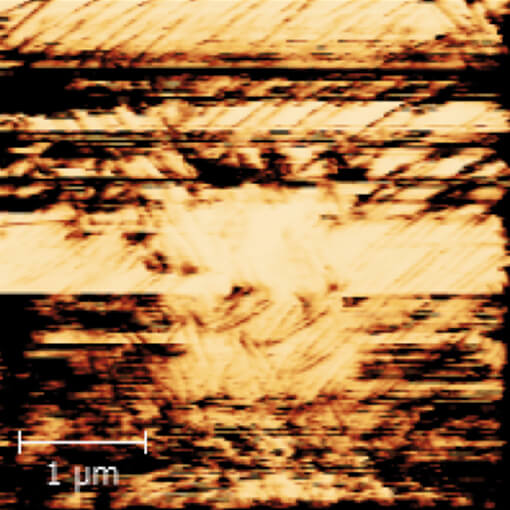
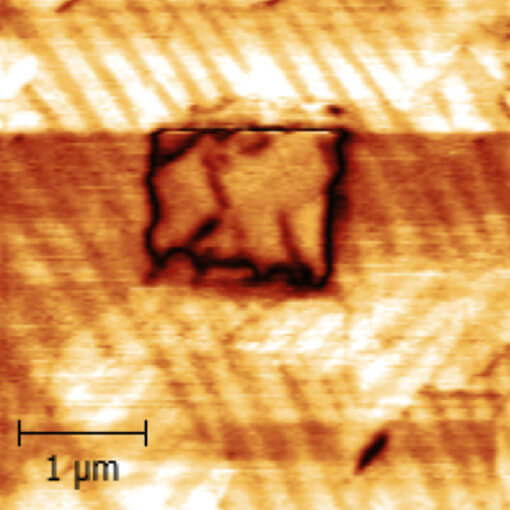
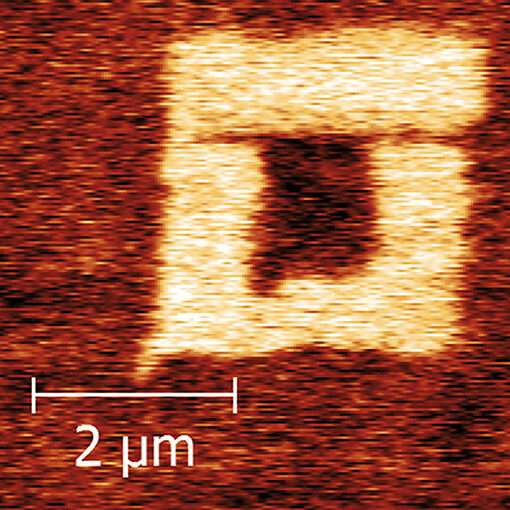
Low Temperature Piezoresponse Force Microscopy on BiFeO
Piezoresponse Force Microscopy (PFM) is a standard tool at room temperature to investigate new materials, especially multiferroics. However, in many cases the scientifically interesting phases only exist at low temperatures or high magnetic fields, what demands the extension of this technique to extreme conditions. In collaboration with our customers, we adapted our attoAFM based on the general purpose ASC500 for PFM measurements. In the measurements shown on the left, we investigated BiFeO3 a well know room temperature multiferroic. The figure shows piezoresponse amplitude after a box in the box writing at 160 K on the sample.
(attocube application labs, 2013; Sample courtesy of Neus Domingo & Gustau Catalan, CIN2 Barcelona, Centre d’Investigació en Nanociència i Nanotecnologia, Bellaterra, Spain)
This measurement was realized with the attoAFM I.
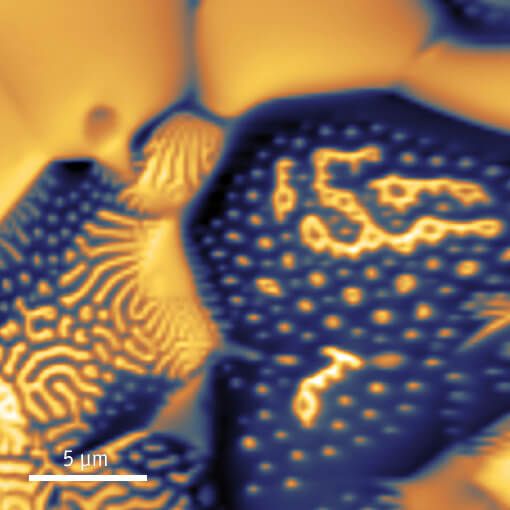
MFM for Optimization of Sintered Magnets
MFM image of a NdFeB sintered magnet with the nominal c-axis orientation perpendicular to the surface. The sample is in the remanent state but some surface grains show already magnetization reversal. High resolution imaging allows deeper insights into the magnetic reversal mechanism and the optimization of magnetic properties. Image size is 30x30µm2.
(Image courtesy of T. Helbig and O. Gutfleisch, Functional Materials Group, TU Darmstadt, Germany and Fraunhofer IWKS Hanau, Germany.)
This measurement was realized with the attoAFM I.

Vortex Barriers in Iron Pnictides
Iron-pnictide high-temperature superconductors are widely studied, but many open questions still remain. Using an attoAFM I for magnetic force microscopy, the group of O. Auslaender has studied twin boundaries and their interaction with vortices over a range of magnetic fields and temperatures. They find that stripes parallel to the twin boundaries repel vortices, effectively hindering vortex motion, and hence potentially affecting the critical current in such materials.
(Data courtesy of O. Auslaender, Technion, Israel)
This measurement was realized with the attoAFM I.
Further reading:
A. Yagil et al., Phys. Rev. B 94, 064510 (2016)
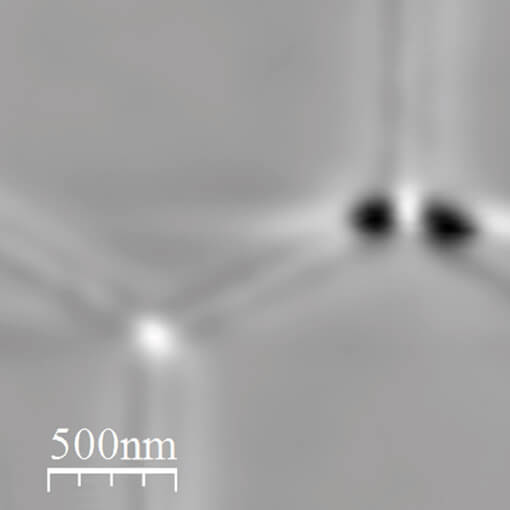
Low Temperature MFM on Artifical Spin Ice
Frustrated systems are intriguing for physicists since they possess highly degenerate ground states with non-zero entropy at 0 K, which can give rise to interesting new phenomena. A prominent example which has been widely studied in condensed matter physics is artificial spin ice. Using Magnetic Force Microscopy (MFM), the group of W. Branford (Imperial College, UK) have studied the magnetic reversal of a nanostructured permalloy honeycomb lattice, demonstrating the breakdown of the artifical spin ice regime at cryogenic temperatures and in high magnetic fields.
(Data courtesy of W.R. Branford, Imperial College, UK)
This measurement was realized with the attoAFM I.
Further reading:
K. Zeissler et al., Scientific Reports 6, 30218 (2016)
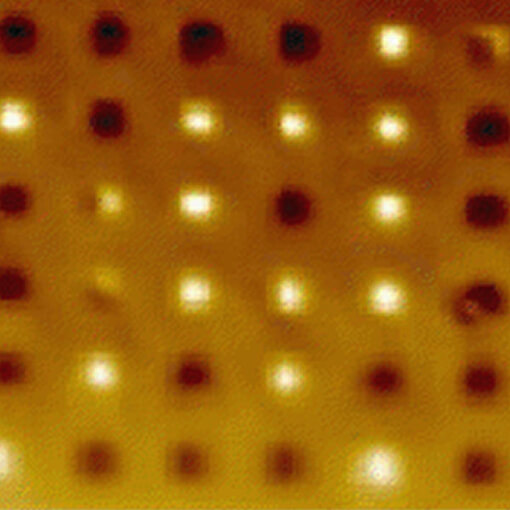
Low temperature magnetization reversal properties of SrRuO3
Understanding the dynamics of magnetization reversal in materials is key to assessing their potential for magnetic storage. Most studies so far have concentrated on room temperature experiments. However, this only represents a narrow range of relevant parameters. L. Landau and co-workers from the group of Lior Klein (Bar-Ilan University, Ramat-Gan, Israel) explored the other end of the parameter range. Using the attoAFM I they studied the low temperature magnetization reversal properties of SrRuO3.
This measurement was realized with the attoAFM I.
Piezo-Response Force Measurements on Ferroic Oxide Films
The renaissance of multiferroics in which at least two ferroic or antiferroic orders coexist, is motivated by fundamental aspects as well as by their possible applications in the field of spintronics. Magnetoelectric coupling allows for instance the reversal of the ferroelectric polarization by a magnetic field or the control of the magnetic order by an electric field. Most of the ferromagnetic-ferroelectric compounds exhibit both orders at low temperature.
In the measurements presented here PFM data have been taken on a layered heterostructure (150 nm BiFeO3-Mn on top of 35 nm of SrRuO3 on a SrTiO3 (001) substrate) recorded at 82 K with a standard attoAFM I. Two squares have been written, a 1 x 1 µm2 and a smaller, rotated one with ±15 V tip voltage. It can be noted that the amplitude goes to zero in the domain walls and that the outside area shows natural domains.
(Images and data courtesy of K. Bouzehouane and S. Fusil, Unité Mixte de Physique CNRS/Thales, Paris, France)
This measurement was realized with the attoAFM I.
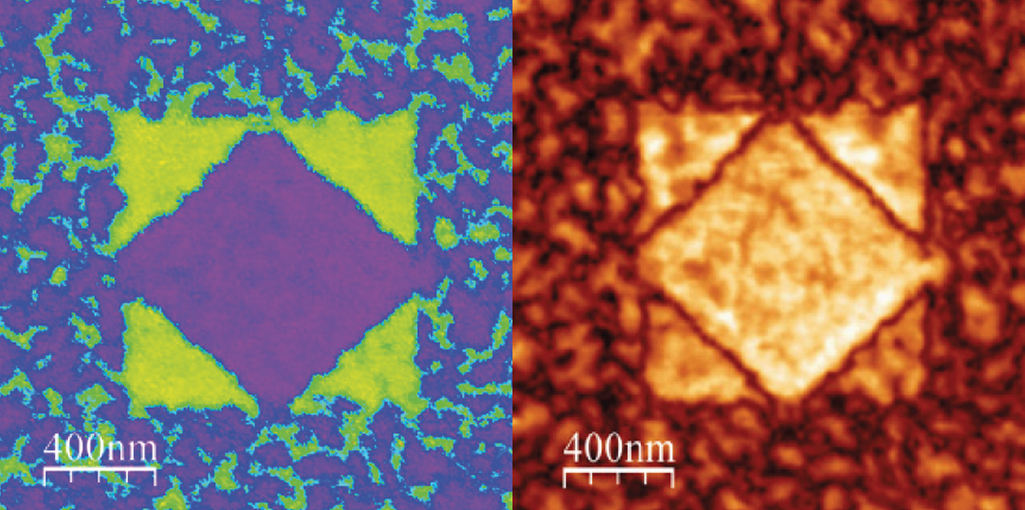
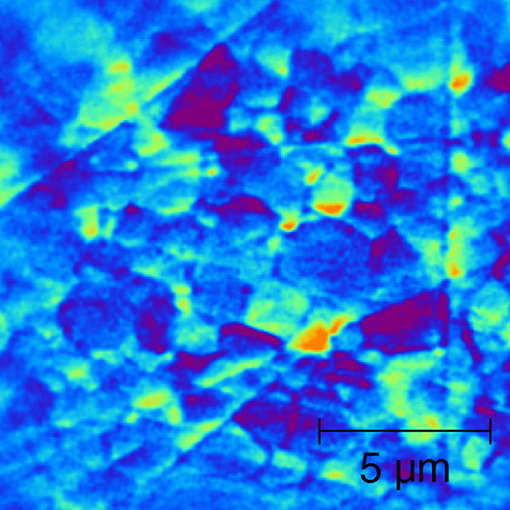
Low Temperature Surface Piezoelectricity in SrTiO3 using Piezo-Response Force Microscopy
SrTiO3 is one of the most investigated materials from the ferroelectric perovskite titanates family due to the variety of physical phenomena ranging from incipient ferroelectricity to superconductivity. Nowadays, considerable interest to SrTiO3 is conditioned by the observations of additional anomalies in the quantum paraelectric regime of SrTiO3, which could be described in terms of a coherent quantum state occurring below T≈37 K. It is supposed that these anomalies are related to the existence of large polarization clusters. Visualizing the dynamic of ferroelectric nanoscale structure at low temperatures may shed light on the mechanisms of the T≈37 K anomaly.
This measurement was realized with the attoAFM I.
Stress-strain behavior of fibrous biological material measured using an AFM/SEM hybrid
In this application, attocube‘s cantilever-based attoAFM I was used inside a FEI Quanta 3D Scanning Electron Microscope (SEM) to perform nanometer-scale tensile measurements of individual collagen fibrils. The fibrils were extracted from the fractured surface of antler and were attached to the cantilever using a high vacuum compatible glue. After the collagen fibril was attached and the glue had hardened, the cantilever was slowly retracted while the force imposed on the collagen fibril was recorded. The measurement was achieved by interferometrically tracking the deflection of the cantilever. With a typical cantilever spring constant of only 0.2 N/m, a force resolution better than 100 pN was readily achieved in a 1 kHz measurement bandwidth. The actual stress-strain measurement of a single collagen fibril indicates an ultimate strength of 0.18 GPa, which is nearly half as strong as structural steel (0.4 GPa).
(Images courtesy of A. Barber, Queen Mary University of London, UK)
This measurement was realized with the attoAFM I.
Further reading:
F. Hang et al., Nanotechnology 22, 365708 (2011)
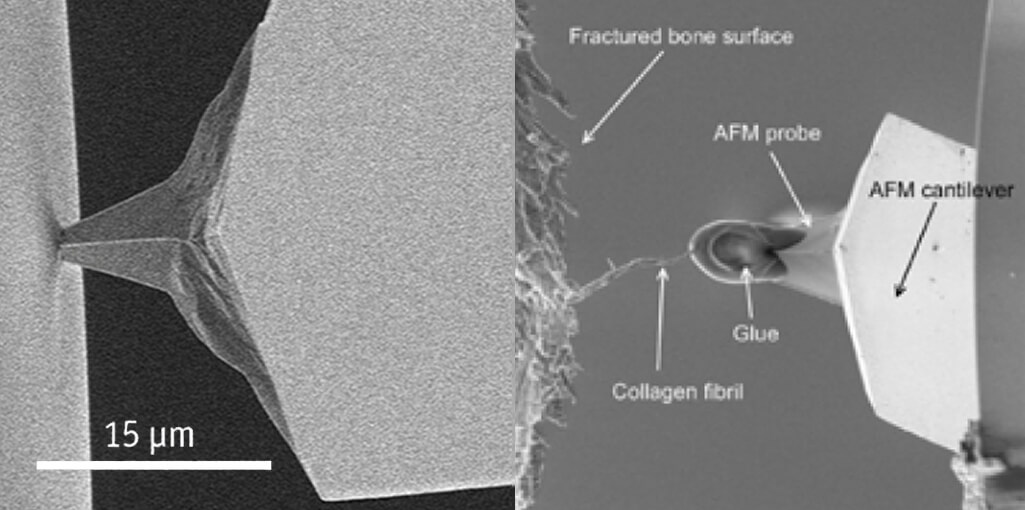
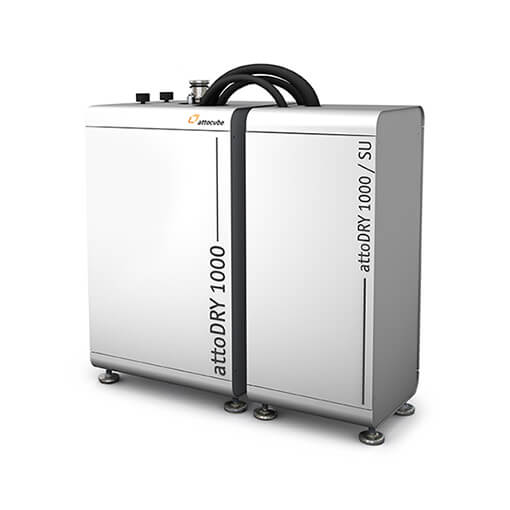
Scanning probe microscopy in an ultra-low vibration closed-cycle cryostat
The attoDRY1000 is a cryogen-free cooling system setting new performance benchmarks. The attoDRY1000 was specifically designed to provide an ultra-low vibration measurement platform for cryogenic scanning probe experiments without the need for liquid helium.
The standard closed-cycle system enables vibration-sensitive experiments in a temperature range from 4 K to 300 K. The optionally available microscope inserts are cooled by a controlled exchange gas atmosphere. Superconducting magnets up to 9 T are available as an option. Due to a proprietary design, mechanical vibrations created by the pulse-tube coldhead are decoupled from the measurement platform.
When measured with the attoAFM I, vibration amplitudes of less than 0.15 nm RMS are routinely achieved (bandwidth of 200 Hz, vertical direction). Despite the mechanical decoupling between coldhead and sample platform, the cooling performance ot the attoDRY1000 is simply outstanding. Temperatures as low as 3 K and probe cooldown times as fast as 1 hour make cryogenic scanning probe experiments a delight.
For the attoDRY1000, a wide variety of scanning probe microscopy inserts is available, ranging from confocal (CFM) to magnetic force microscopy (MFM).
This measurement was realized with the attoDRY1000, and the attoAFM I.
Further reading:
F.P. Quacquarelli et al., arXiv:1404.2046v1
Visualization of Edge State in LPCMO Manganite Strip
Edge states that are induced by broken symmetry effects in two-dimensional electronic systems are in the focus of research. However, the question about the existence of edge states in strong correlated oxides was not fully answered until the group of Prof J. Shen (State Key Laboratory of Surface Physics and Department of Physics, Fudan University, Shanghai, China) demonstrated edge states in exactly these type of materials.
They used La0.325Pr0.3Ca0.275MnO3 (LPCMO) manganite strips and characterised these with an attoAFM Ixs with the upgrade for magnetic force measurements in a PPMS system at low temperatures. Experimental results including MFM images help to understand the edge states which are associated with the broken symmetry effect in manganites. The Figure shows MFM images under 9T and at temperatures of 10 K and 120 K. The scanned areas are 20?µm × 20?µm in the figures of the first row and 15?µm × 15?µm below.
Their findings prove the existence of novel edge state in strongly correlated oxides beyond the current two-dimensional electronic systems and opens a new understanding of broken symmetry effects in complex oxides.
(Image courtesy of K. Du, K. Zhang, and J.Shen, Fudan University, Shanghai, China)
This measurement was realized with the attoAFM I.
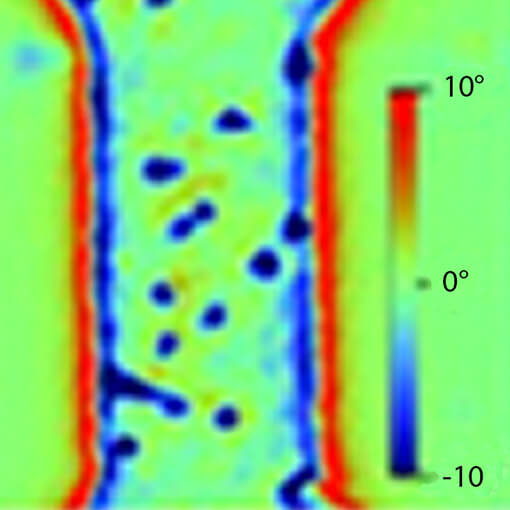
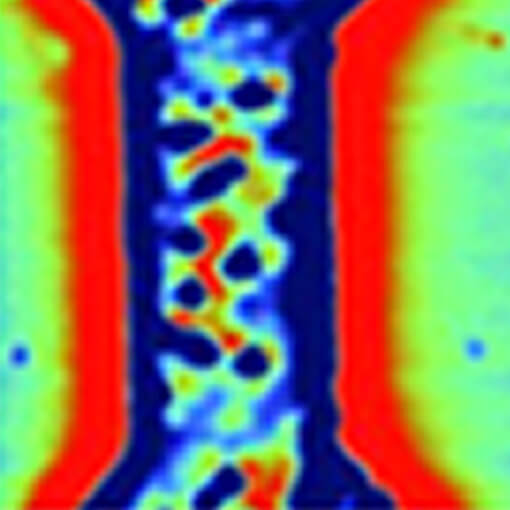
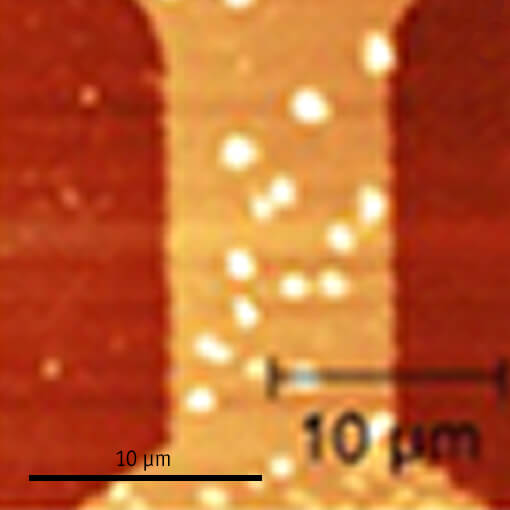
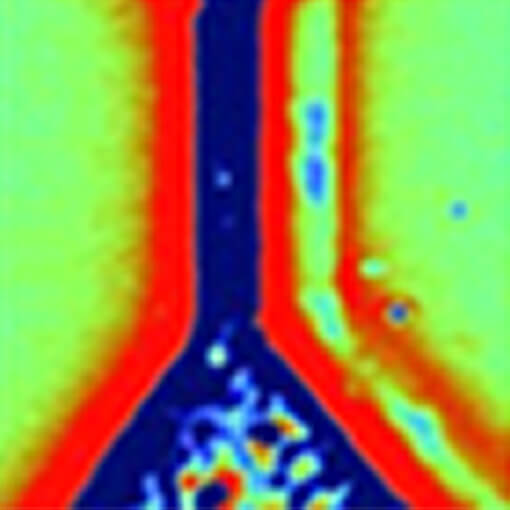
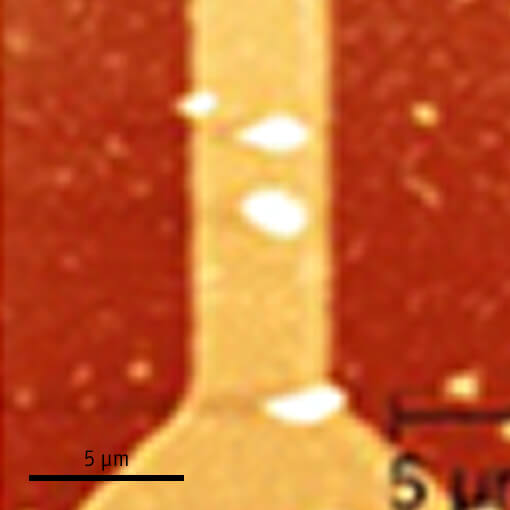
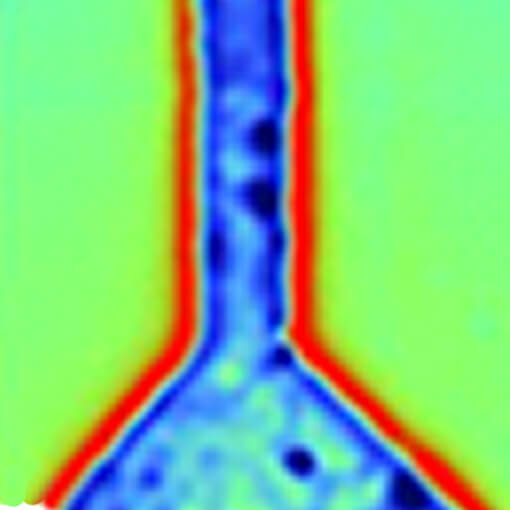
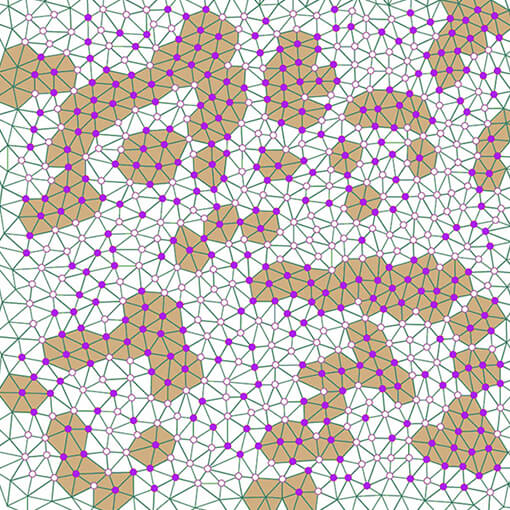
Vortex Imaging on Iron Pnictides using the attoMFM Ixs
In their latest publication, H. Yang and co-workers from the group of Prof. Hai-Hu Wen, from Nanjing University, present results on vortex studies on Ba1-xKxFe2As2 - a potassium-doped superconductor of the pnictide family. Since their discovery in 2008, the iron-pnictides have drawn intensive attention, not only because they have broken the monopoly of the cuprates but also because of strong pinning effects observed in certain pnictide-compounds. A vortex consists of a circular supercurrent, which allows for exactly one flux quantum each to penetrate the superconductor.
This measurement was realized with the attoAFM I.
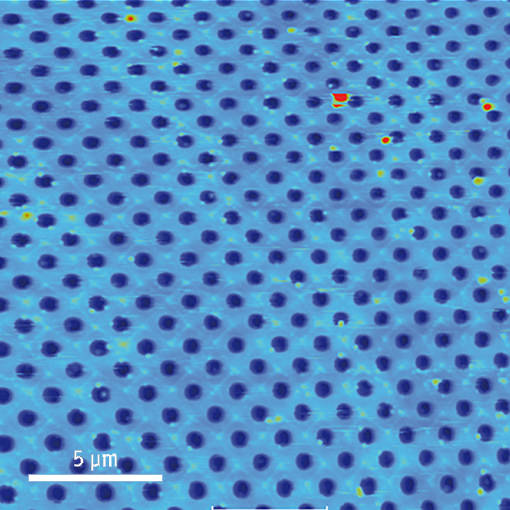
attoAFM I Mounted on Mixing Chamber
This scan above nicely demonstrates the stability of a complete system, an attoAFM I together with a LD400 cryo-cooler from BluFors Cryogenics. For this 25 x 25 µm2 (800 x 800 pixel) scan, the pulse-tube cooler was enabled the whole time. The temperature was stable at ≈40 mK measured at the mixing chamber - it was slightly higher due to the higher scan speed of close to 1 µm/s.
(attocube applications in collaboration with BluFors Cryogenics, 2014)
This measurement was realized with the attoAFM I.
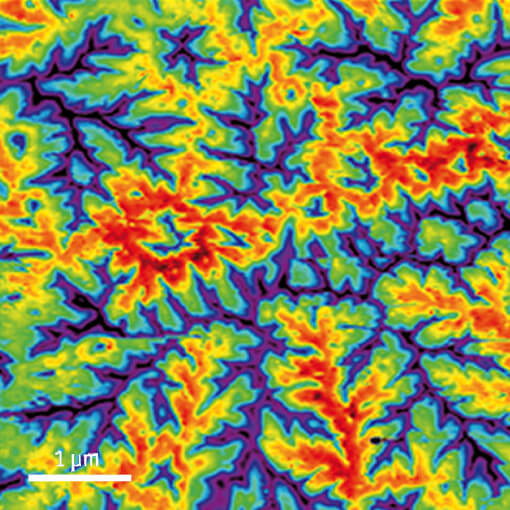
MFM on Co Doped Mn2Sb Single Crystal
Magnetic domain structure in the ferrimagnetic state of Co doped Mn2Sb single crystal imaged using an attoAFM Ixs Magnetic Force Microscopy (here at 290 K). The image was taken in constant distance mode with the height above the sample surface set to 50 nm. The area shown in the figure corresponds to 15 µm x 15 µm with a size of 800 x 800 pixel.
(Image courtesy of Rajeev Rawat, UGC-DAE Consortium for Scientific Research, Indore, India)
This measurement was realized with the attoAFM I.
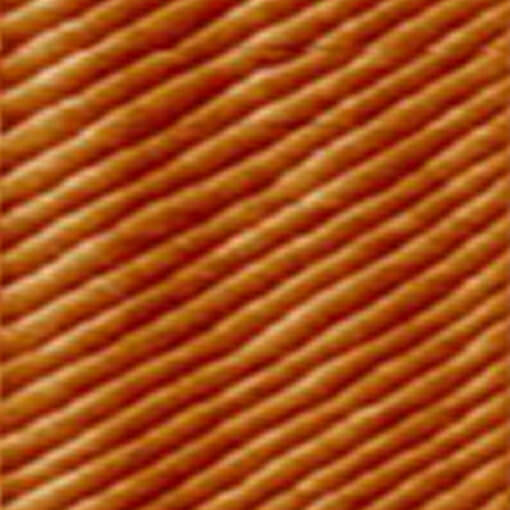
Link between bulk electric and microscopic magnetic properties of LaPryCaMnO
A research team around Prof. Jian Shen from the low-dimensional material physics group at Fudan University (China) has studied extensively thin films of manganites (LaPrCaMnO on SrTiO). This family of materials has very unique electronic and magnetic properties, which can be tailored for all sorts of spintronic and electronic applications.
Their findings have been published in a series of 5 papers, in which they have been using an attoAFM/MFM Ixs in an attoDRY1000 & PPMS to characterize the microscopic origins of a magnetic and electronic phase separation at low temperatures and in high magnetic fields controlled by nanopatterning as well as shedding light on the connection between bulk electric and microscopic magnetic properties of such films.
This measurement was realized with the attoAFM I.
Switching the Magnetic Vortex Core in a Single Nanoparticle
Manipulating magnetic nanostructures is not only scientifically interesting but also offers great potential in nonvolatile data storage devices and spintronic applications.
Elena Pinilla-Cienfuegos and co-workers used a low temperature variable field attoAFM/MFM I to observe and manipulate the magnetic vortex states in 25nm diameter molecular-based magnetic nanoparticles. They found that the vortex core can be switched by the application of a very small magnetic field.
This measurement was realized with the attoAFM I.
Further reading:
E. Pinilla-Cienfuegos, et al., ACS Nano 10 (2), 1764–1770 (2016)
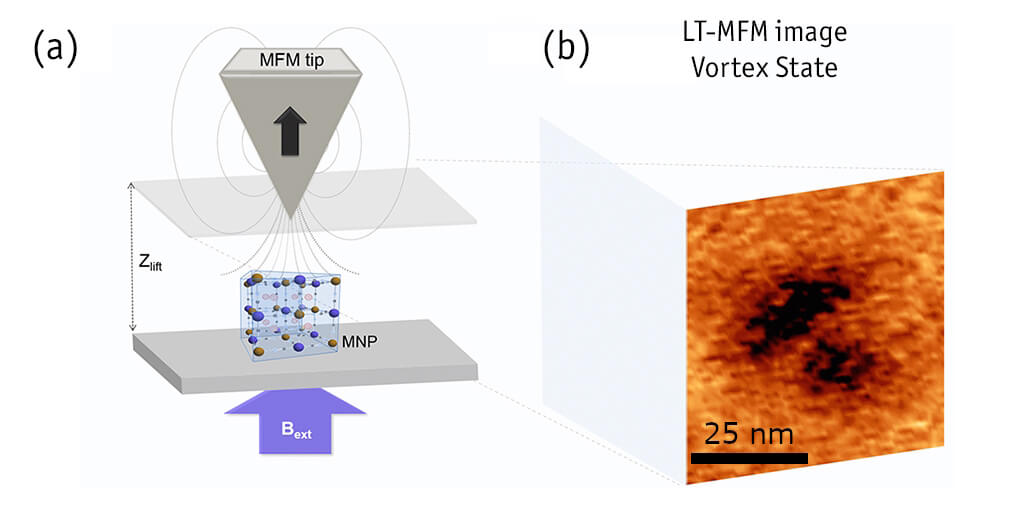
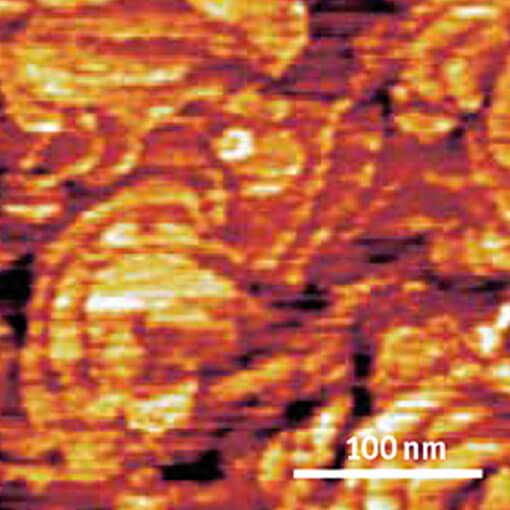
Conductive-Tip AFM Measurements on Ruthenium
In this application, atomic steps on Ruthenium were investigated using conductive-tip AFM. Atomic steps as well as spiral dislocations can be identified on the molecular beam epitaxy-grown sample. The contrast in this measurement is highly enhanced due to a difference in conductance between edges and flat plateaus. Such high contrast was not observed in the accompanying topographic image. A voltage of +10 mV was applied to the standard Pt-coated AFM tip, while the sample was grounded via a current amplifier with gain 106 V/A. The measurement was performed at room temperature in a 20 mbar He atmosphere.
(Sample and measurement courtesy of V. Da Costa, J.-F. Dayen, B. Doudin, IPCMS-DMONS,CNRS/University of Strasbourg, France)
This measurement was realized with the attoAFM I.
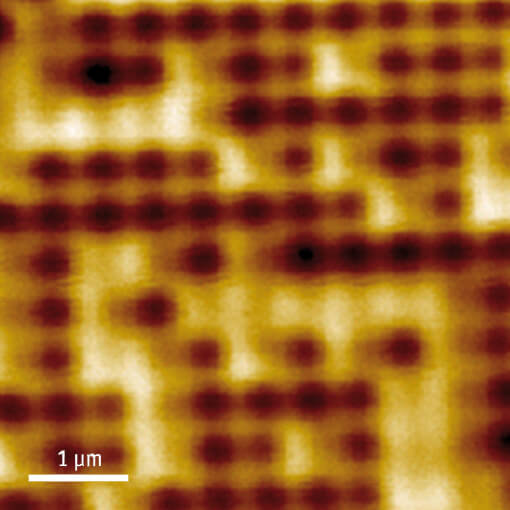
High Resolution MFM on Bit Patterned Media Co-Pd at 10K
MFM measurement on Co-Pd dots with 50 nm diameter at 10 K using the attoMFM I. The image demonstrates the high magnetic resolution achievable with the attoMFM at cryogenics. Variations in magnetic field perpendicular to the surface allows switching domains from one magnetic state to the other (here recorded at 6250 Oe). For this measurement, the attoMFM was operated at constant height with the frequency shift measured using a phase-locked loop.
(attocube application labs, 2010; sample courtesy of Hitachi Global Storage Solutions, San Jose, USA)
This measurement was realized with the attoAFM I.
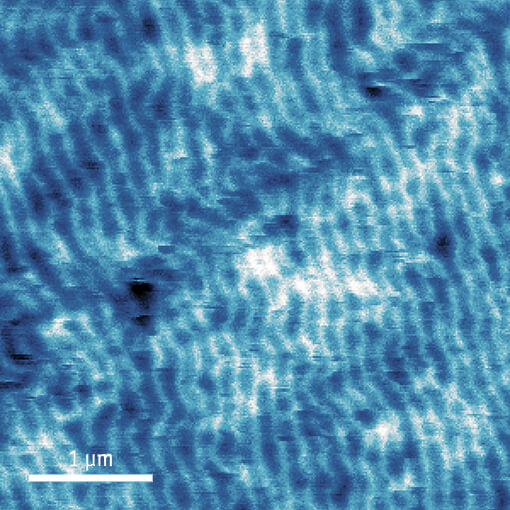
Helimagnetic Phase of FeCo0.5Si0.5
Real space imaging of exotic magnetic phases provides a level of understanding that cannot be achieved with indirect techniques. The figure on the left shows one of the first observations of a helimagnetic phase using the attoMFM I. The periodicity of the stripes is around 100 nm. This phase is of particular interest because of its proximity to a skyrmion phase. Skyrmions are exotic magnetic excitations, studied extensively because of their potential use in spintronic applications. The measurement was performed on a FeCo0.5Si0.5 sample at cryogenic temperature (4K) using an attoMFM I inside a liquid helium cryostat (attoLIQUID).
(attocube application labs, 2013; sample courtesy of A. Bauer and C. Pfleiderer, Technical University of Munich, Garching, Germany)
This measurement was realized with the attoAFM I.
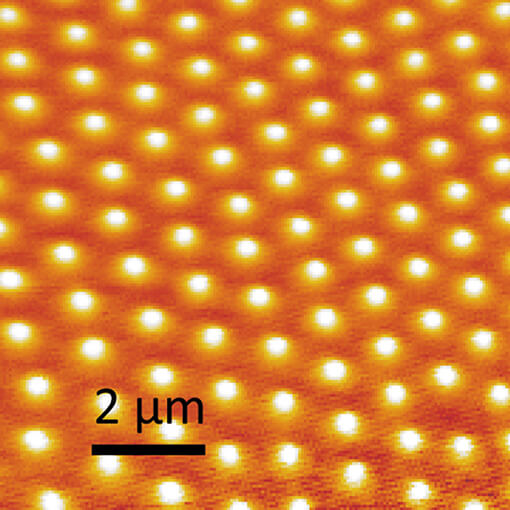
MFM on Superconducting Vortices in BSCCO
This measurement shows a dominantly hexagonally ordered Abrikosov votex lattice, at a magnetic field of -40 Oe (the sample was field-cooled) and liquid helium temperatures. The orientation of the vortices with respect to the moment of the tip is indicated by the color of the vortices: Bright colors indicate repulsive forces. The tip was scanned in a constant height of about 30 nm above the surface of a freshly cleaved piece of BSCCO-2212. Note that the applied field is much lower than the coercitivity of the hardmagnetic tip (≈400 Oe), hence the orientation of the tip moment is unchanged. Scan size is 10 x 10 µm2, color span is 2 Hz.
(attocube applications labs, 2013; sample courtesy of A. Erb, TU Munich, Germany)
This measurement was realized with the attoAFM I.
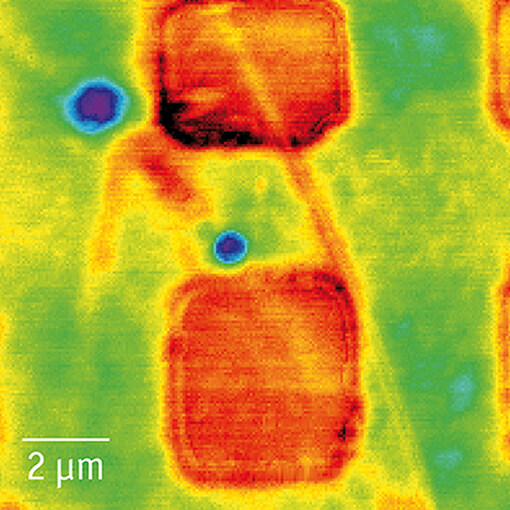
KPFM of Au-on-Pt Pattern
The kelvin probe force microscopy (KPFM) measurements shown here were performed on a test sample consisting of a Au layer on a Pt substrate in dual pass mode at cryogenic temperatures of 4K. The KPFM image was recorded during the second line with a lift height of about 50 nm. The color scale spans approximately 130 mV, and the image size is 11.9 µm x 11.9 µm.We found a KPFM contrast of approx. 35 mV, and a KPFM resolution (noise level) of approx. 2.6 mV.
(attocube application labs 2014)
This measurement was realized with the attoAFM I.
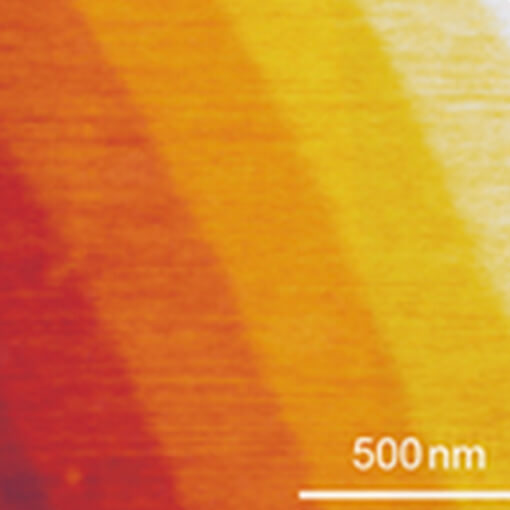
Atomically Flat Terraces
Image of atomically flat terraces on a 0.1° canted SrTiO3 surface using a standard attoAFM I made for cryogenic application. The height difference for each terrace is about 0.39 nm which demostrates the height resolution that is possible with the attoAFM I used with an attoLIQUID. Acquisition time for this 150 x 150 pixel image of size 2 x 2 µm2 (13 nm pixel size) was about 15 min.
(attocube application labs, 2007)
This measurement was realized with the attoAFM I.
Ferroelectric Domain at Cryogenic Phase Transitions
Ferroelectric barium titanate (BTO) exhibits several ferroelectric phase transitions at cryogenic temperatures, resulting in severe structural changes and domain formation. Using an Attocube AFM I, the group of Prof. Eng (Institute of Applied Physics, Dresden University of Technology, Dresden, Germany) has investigated this domain dynamics in BTO single crystals applying both piezoresponse force microscopy (PFM) and Kelvin probe force microscopy (KPFM) down to 10 K. The two images display the PFM signal (a) and surface potential measured by KPFM (b) in contact and non-contact mode, respectively, over the same 15 µm x 15 µm sample area at T = 220 K (orthorhombic BTO phase).
This measurement was realized with the attoAFM I.
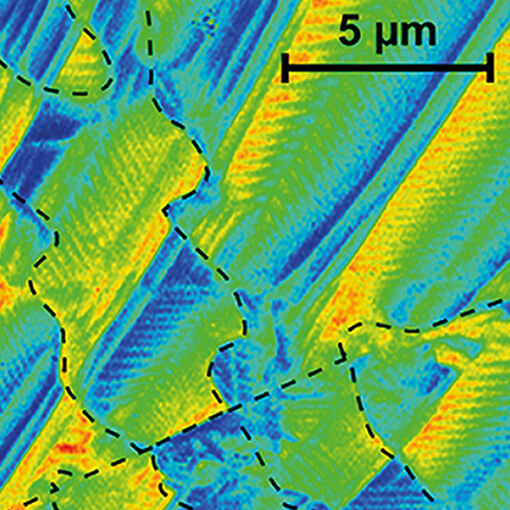
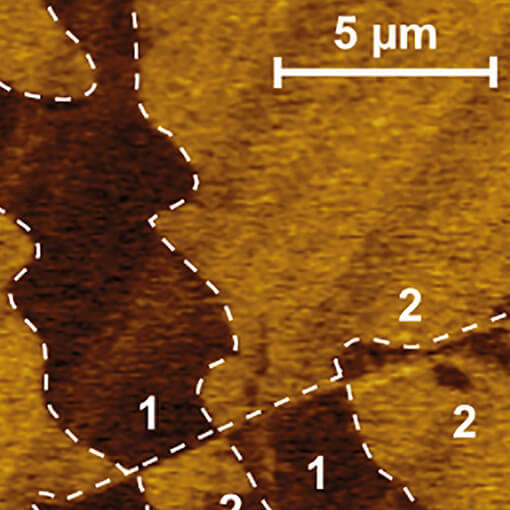
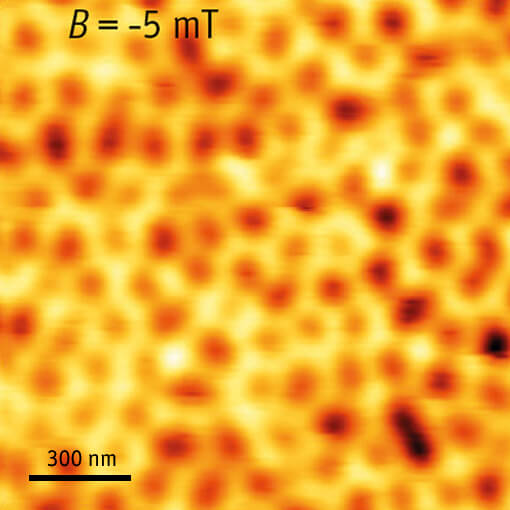
MFM imaging of a Skyrmion lattice
In collaboration with Jan Seidel from UNSW Sydney, A. Bauer & C. Pfleiderer, TU Munich we have successfully imaged the elusive Skyrmions and their magnetic field evolution in the attoDRY1000 cryostats using the attoAFM/MFM I. See what’s possible nowadays with our sophisticated commercial instruments!
This measurement was realized with the attoDRY1000, and the attoAFM I.

